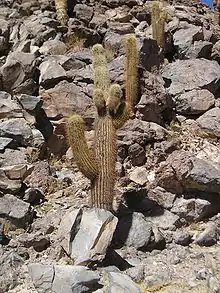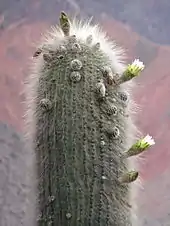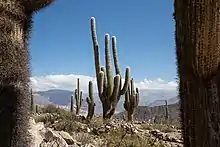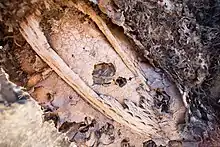Echinopsis atacamensis
Echinopsis atacamensis (cardón) is a species of cactus from Chile, Argentina and Bolivia. The wood of this species can be used in building and in making furniture.[1]
| Echinopsis atacamensis | |
|---|---|
 | |
| Scientific classification | |
| Kingdom: | Plantae |
| Clade: | Tracheophytes |
| Clade: | Angiosperms |
| Clade: | Eudicots |
| Order: | Caryophyllales |
| Family: | Cactaceae |
| Subfamily: | Cactoideae |
| Genus: | Echinopsis |
| Species: | E. atacamensis |
| Binomial name | |
| Echinopsis atacamensis | |
Description
Echinopsis atacamensis has a tall columnar habit, sometimes forming branches and becoming treelike. It grows to about 10 m (33 ft) high, with stems to 70 cm (27.6 in) across. The stems have 20-30 ribs and areoles with 50-100 maroon coloured spines, the longest up to 30 cm (12 in) long. The rose-white flowers are 10–14 cm (3.9–5.5 in) long, borne on the sides of the stems. The dark green fruits are densely covered with hairs, up to 5 cm (2.0 in) long; they are edible.[1]



Systematics
Echinopsis atacamensis was first described by Rodolfo Philippi as Cereus atacamensis in 1860. It was placed in a number of genera, including Trichocereus and Helianthocereus, before being moved to Echinopsis by Helmo Friedrich and Gordon Rowley in 1974.[1]
There are two recognized subspecies. Subspecies pasacana is often branched, and occurs in Argentina and Bolivia. Subspecies atacamensis is usually unbranched, less tall (up to 6 m (20 ft) rather than 10 m (33 ft)), and is found in Chile.[1]
References
- Anderson, Edward F. (2001), The Cactus Family, Pentland, Oregon: Timber Press, ISBN 978-0-88192-498-5, pp. 257–258
| Wikimedia Commons has media related to Echinopsis atacamensis. |